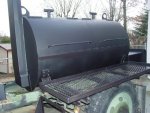THe following is an exerpt from TM 43-0139 "PAINTING INSTRUCTIONS FOR ARMY MATERIEL"
2-31. CHEMICAL AGENT RESISTANT COATINGS (CARC)
a. General. Chemical Agents pose a devastating threat to sustained readiness in a combat environment. CARC paints were developed to minimize the impact of this threat. CARC paints are relatively impermeable coatings which do
not absorb/desorb chemical agents, and which do not break down when decontaminated.
(1) A common misconception is that CARC paints present greater health/ safety/ environmental hazards than do other paints. In fact, the health and safety requirements for CARC are the same as those for all paints. And, although CARC paints are currently more expensive and require additional care in application, their durability make overall life cycle costs/efforts less than those of other paint systems.
(2) There are currently three CARC paints:
(a) MIL-C-46168 a two-component aliphatic polyurethane used on exterior surfaces and those interior surfaces frequently exposed (eg, ramps, hatches).
(b) MIL-C-53039 a single component aliphatic polyurethane used wherever MIL-C-46168 may be used.
(c) MIL-C-22750 a two-component epoxy polyamide enamel used only on interior surfaces.
b. Coating, Aliphatic Polyurethane, Chemical Agent Resistant (MIL-C-4616 Two-Component.
Two-Component.
(1) Characteristics. This specification covers both camouflage and non-camouflage color chemical agent resistant aliphatic polyurethane coatings (CARC). CARC is designed for easy decontamination after liquid chemical agent exposure. It is available in a standard formula (Type II), and a high-solids VOC compliant formula (TYPE IV). Types II and IV are all lead and chromate free.
It appears to me that CARC paint is nothing more than a high quality automotive polyurethane paint that is no more hazardous than the Alkyd enamel that so many of us on this board are so fond of, or at most no more hazardous than comercially available automotive Polyurethane paint.
Here's another publication that talks about it:
http://www.olive-drab.com/archive/carc_paint.pdf
And another one discussing CARC paint:
http://www.gulflink.osd.mil/carc_paint_ii/carc_paint_ii_s03.htm#iii
Anyone here care to comment on this?
2-31. CHEMICAL AGENT RESISTANT COATINGS (CARC)
a. General. Chemical Agents pose a devastating threat to sustained readiness in a combat environment. CARC paints were developed to minimize the impact of this threat. CARC paints are relatively impermeable coatings which do
not absorb/desorb chemical agents, and which do not break down when decontaminated.
(1) A common misconception is that CARC paints present greater health/ safety/ environmental hazards than do other paints. In fact, the health and safety requirements for CARC are the same as those for all paints. And, although CARC paints are currently more expensive and require additional care in application, their durability make overall life cycle costs/efforts less than those of other paint systems.
(2) There are currently three CARC paints:
(a) MIL-C-46168 a two-component aliphatic polyurethane used on exterior surfaces and those interior surfaces frequently exposed (eg, ramps, hatches).
(b) MIL-C-53039 a single component aliphatic polyurethane used wherever MIL-C-46168 may be used.
(c) MIL-C-22750 a two-component epoxy polyamide enamel used only on interior surfaces.
b. Coating, Aliphatic Polyurethane, Chemical Agent Resistant (MIL-C-4616
(1) Characteristics. This specification covers both camouflage and non-camouflage color chemical agent resistant aliphatic polyurethane coatings (CARC). CARC is designed for easy decontamination after liquid chemical agent exposure. It is available in a standard formula (Type II), and a high-solids VOC compliant formula (TYPE IV). Types II and IV are all lead and chromate free.
It appears to me that CARC paint is nothing more than a high quality automotive polyurethane paint that is no more hazardous than the Alkyd enamel that so many of us on this board are so fond of, or at most no more hazardous than comercially available automotive Polyurethane paint.
Here's another publication that talks about it:
http://www.olive-drab.com/archive/carc_paint.pdf
And another one discussing CARC paint:
http://www.gulflink.osd.mil/carc_paint_ii/carc_paint_ii_s03.htm#iii
Anyone here care to comment on this?










